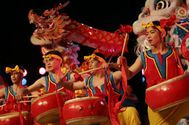Celebrating The Chinese New Year
In February, the festive celebration of the Chinese New Year takes place all over the Philippines. In some areas, the festivities will run for an entire week in February.
This means that Filipino-Chinese communities scattered across the nation will be one in welcoming the Year of the Rat the moment the clock strikes 12:01 A.M. on the 7th of February. Under the Lunar calendar, it will already mark the beginning of the year 4706 – the Year of the Rat.
The Chinese New Year is as important for the Chinese just as January 1st is for Filipinos and the rest of the Christian world. In a nation where Filipinos and Chinese co-exist, it’s impossible not to feel the festive mood that comes with the Chinese New Year. It is always celebrated in the Philippines and because of this, for Filipinos, it’s like ushering a “second New Year” right after January 1st.
For many, many years, Chinese presence here has been well-established so much that almost anything Chinese has seemingly rubbed off on Filipinos – from food and business practices to certain beliefs that have much to do with New Year welcome preparations.
Most notable among these beliefs is that of ensuring that all debts are settled, preparing a platter of an odd number (usually around 13) of round-shaped fruits on the table, and yes, even general housecleaning – all before the arrival of the coming year. Thus, it is not really unusual for houses and business establishments to get fresh coats of paint just as the application of the art of Feng Shui in life is not surprising.
The ever-popular Feng Shui, Chinese words that mean air (FENG) and water (SHUI), is a traditional way of arranging things inside the home or office to guarantee balance in life. Feng Shui, however, is not a religion, but an ancient Chinese art that has gained popularity worldwide owing to its use as a means of inviting prosperity and good luck in life.

One of the most fascinating sights to behold in every Chinese New Year celebration is the parade which is usually highlighted by the beautiful and colorful Lion and Dragon Dances wherein several dancers would hide under Lion or Dragon-headed props in bright red and gold and gyrate to the beat of drums, gongs, and cymbals. Adding more fun and excitement are the acrobats and stilt walkers strutting their stuff around in such a riveting way that onlookers couldn’t help but be captivated.
Of course, the Chinese New Year would not be complete without noise – in the form of fireworks. What’s a New Year celebration like without fireworks, anyway? Dull, probably. The Chinese New Year though, is anything but dull. To the Chinese, creating noise helps to ward off or drive away bad spirits or bad luck and this explains all the fireworks that go off during their New Year celebrations. Just like the typical Filipino New Year celebrations when families wake up and gather around for the Media Noche (midnight snack), so do Chinese families share family feasts, but the morning after is reserved for their traditional giving away of the “ang paus” which are small, red envelopes filled with “good luck money” as they call it. About the most popular Chinese delicacy often given away as a symbol of prosperity and unity is the sticky rice cake or the famous “tikoy” which Filipinos have learned to enjoy among other delicious Chinese foods.
The Chinese New Year celebration is mostly all about prosperity, good fortune, and happiness in life. If you ever find yourself in Cebu or anywhere else in the Philippines and you hear fireworks blasting away in mid-February, never worry about war possibly erupting – it’s simply the Filipino-Chinese residents eagerly celebrating the Chinese New Year.
To all the Chinese and Filipino-Chinese living in Cebu and across the Philippines, KUNG HEI FAT CHOI! Happy New Year, everyone!!!


